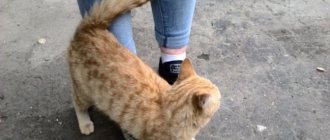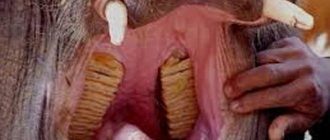Can animals cry?
Do animals cry? For a long time it was believed that crying and tears are the prerogative of humans, and they have nothing to do with animals. However, there is another opinion. Just like people, animals are capable of experiencing negative emotions, which lead to the appearance of tears. At the same time, everyone cries: crocodiles, sea otters, beavers, dogs, and even bulls participating in bullfights. And this is not fiction, but very real facts.
Of course, the process of tears appearing in animals can be associated with the natural reaction of their body, thus trying to free itself from accumulated salts. This may be true, but how then can we explain the crying and tears of sea otters who have lost their babies?
The same beaver, for example, is crying bitterly over the loss of his home. The animal becomes phlegmatic, stops reacting to danger, and even the threat of death does not frighten it. According to eyewitnesses, crying beavers can be found on the side of roads. Well, they cry like children, with sobs and tears. Hence the saying “tears like a beaver’s.” So it turns out that tears in animals can be caused not only by pain, but also by various emotions.
An example can be taken from the life of the same beavers. Individuals of the opposite sex belonging to different families find it very difficult to get along with each other. Usually reconciliation occurs after several fierce fights. It is very touching to watch how the male and female approach each other with tears of friendship in their eyes. This means that peace has been established between them.
The cause of beaver tears can be the loss of offspring. Having lost her babies, the female cries for several days, and large tears drip from her eyes. She stops eating, loses weight, and may even die.
Dogs can cry not only from pain, but also from jealousy. As it turns out, they are not deprived of this feeling. Jealousy arises when another four-legged animal appears in the house and receives increased attention. In the end, this may end in a fight between the animals, who thus defend their right to primacy. At the same time, both dogs experience enormous stress, which can result in crying and tears.
According to bullfighters, bulls can also cry during a bullfight. They fall to their knees and cry like children. The spectacle is, of course, very impressive.
Whether or not to believe all these facts is a purely personal matter. According to scientists, only humans are capable of crying, while animals express their emotions somewhat differently. They whine, squeal, growl, and use various gestures.
Then where do our four-legged friends' tears come from?
There is an opinion that these are not tears at all, but a liquid filled with salts, which is secreted from the animal’s body by glands located near the eyes. That's why the same crocodiles cry. Sea snakes, lizards, and iguanas are similarly freed from salts. Sea turtles also cry when they land. The reason for their tears is not at all related to emotions, but is purely physiological in nature.
The fluid that appears in the eyes of some animals may be related to their sexual desires. It contains pheromones that serve to attract individuals of the opposite sex. This technique, for example, is used by male mice who begin to cry with the onset of mating season. These tears are incredibly attractive to the female, who becomes hostage to pheromones. So it turns out that instead of emotions and feelings, animals only have reflexes and instincts.
Biology of crying
From a biological point of view, there are three types of tears. One of them is basal tears, which are produced automatically to moisturize and cleanse the eyes. They arise from accessory lacrimal glands located under the eyelids. In addition, there are reflex tears that appear due to external irritants, for example, while cutting onions or damaging the eyes.
The third type is emotional tears, the only type that we have some control over.
The last two types of tears are produced by the lacrimal glands at the top of the eye sockets.
“One argument is that emotional crying is very much like an emotional reflex rather than a physical one,” says Mark Baker, a researcher at the University of Portsmouth in England who studies crying in adults.
Some scientists hypothesize that the purpose of crying is simply another biological function. For example, biochemist William Frey suggested in the 1980s that crying balances hormone levels in our bodies, thereby relieving stress. He also believed that crying cleanses the human body of toxins, although later research has refuted this.
Charles Darwin believed that children cry to get rid of negative emotions physically.
What all theories have in common is that crying brings us back to balance. After all, it's not uncommon for people to say that they feel much better after they've cried.
Physical discomfort is the reason for a cat's crying
We made it clear above that cats can cry due to many illnesses. Even improper functioning of the kidneys and thyroid gland can lead to watery eyes. Additionally, a cat that is in pain will actually cry.
https://youtube.com/watch?v=odiFVTMbw1M
If you think your cat is crying, do the following:
- Run your hand over the back, sides and belly of the cat (from head to tail) - check for wounds, injuries, swelling, tumors, tangles.
- Inspect the ears, chin, armpits, inner thighs, base of the tail, and the space between the toes to check for parasites.
- Examine your mouth, nose, and eyes for dried discharge.
- Make sure your cat is breathing normally.
- Inspect the paws and claws.
- Inspect the tray to see if the cat goes to the toilet and if there are worm eggs in the feces.
If you conclude that your cat's discomfort is caused by stress, you should:
- Hold your pet more often.
- Allow your pet to sleep with you (if appropriate).
- Distract your cat with games.
- Avoid quarrels, do not invite guests.
If the cat's condition worsens, you need to contact a veterinarian who will prescribe a course of sedatives.
What does it mean when a cat cries?
Most often it occurs due to chemicals in various deodorants, air fresheners, and household chemicals. The cause may be pollen, dust, food, and various food additives. If the allergy is related to food, then changing your diet will help cope with it; if the reason is different, you should consult a doctor.
Interesting materials:
How long does a tan last? How long did Tereshkova’s flight last? How long does the interview last? How long does it take for a package to arrive in the USA? How long does a magnet retain its properties? How long should you cook oyster mushrooms? How long does it take for tree leaves to decompose? How long does it take to remove henna from eyebrows? How long does it take for wet firewood to dry? How long are messages saved on the WhatsApp server?
Psychology of crying
One of the most compelling explanations is that crying is part of our social needs. Crying is a clear visual signal that something is wrong. He instantly communicates that someone may need help. When people pay attention to a crying person, it contributes to the creation of a cooperative social environment, which is very complex in humans.
Cornelius' research supports this theory that tears are a quick and effective social signal. In a series of experiments, he and his colleagues showed participants photographs of faces (without revealing the purpose of the study) and asked them to interpret emotions. In some photos, people were crying with tears, and in other photos, tears were wiped from their faces.
After viewing pictures of tears, almost every participant was able to identify sadness or grief. At the same time, pictures without tears confused people.
“Without tears, emotions almost disappear,” says Cornelius.
This indicates that tears are a powerful signal to others about our immediate emotional state. Real tears are difficult to depict, which is one reason why crying is so difficult to study in the laboratory.
Tearing in pets
The psychophysiological reaction in the form of increased secretion of tear fluid is characteristic only of humans. It is caused by strong negative or positive emotions. If a cat cries, then excessive lacrimation is always explained by physiology or pathology.
In animals, tear fluid performs 3 important functions:
- optical (participates in the refraction of light for a clear perception of the picture of the world);
- trophic (nourishes the cornea and conjunctiva with useful substances);
- protective (removes foreign particles from the surface of the eye).
That is, excessive lacrimation in pets is always associated with irritants or drying out of the inner membrane of the eye. Scary dreams and other psycho-emotional reasons do not play a role in this case.
Physiological reasons
Despite the possibility of a pathological explanation, do not panic ahead of time. The appearance of tears can also be due to completely harmless reasons:
- slight irritation of the mucous membrane due to dust, specks or hairs;
- lack of ability to wash oneself without outside help (along with tears, the discharge accumulated during the day is removed);
- recent sleep (discharge from the eyes also forms during rest, and tears help get rid of them);
- vigorous physical activity (night “tygydyks”, chasing birds), stimulating the work of the lacrimal glands;
- sniffing freshly chopped onions.
If your pet looks healthy, then he is unlikely to need the help of a veterinarian. For physiological reasons, lacrimation normalizes on its own.
Pathological causes
An alarm bell is prolonged lacrimation, accompanied by accompanying symptoms. In such a situation, the likelihood of the following pathologies is high:
- allergy;
- viral conjunctivitis and other infections;
- inflammation of the upper respiratory tract;
- various injuries, including foreign body penetration;
- helminthic infestations;
- ophthalmological diseases (cataracts, dacryocystitis, distichiasis, entropion and eversion of the eyelids);
- endocrine disorders and problems with the digestive system.
If the animal shows signs of illness, be sure to seek help from a veterinarian. Treatment recommendations will depend on the diagnosis.
Breed feature
Persians, exotics, Britons and Scots are united by a specific skull structure. The nasal passages and tear ducts of representatives of these breeds are shorter than those of other mustachioed pets. Because of this, their eyes water profusely at any, even the most minor, irritation of the mucous membrane.
Snub-nosed cats require more careful care, as tear secretions change the color of their fur and form pathogenic microflora for bacteria. Such pets need to wipe their eyes at least once a day.
What to do about lacrimation in animals
Possible actions directly depend on the cause. If everything is explained by physiology, then it is enough to wait for the condition to normalize or help your pet with eye hygiene. Special veterinary lotions, herbal decoctions or weak tea leaves are suitable for cleansing.
When pathology is confirmed, it is enough to simply follow medical recommendations. Depending on the diagnosis, a mustachioed pet may be prescribed antibiotics, antivirals, anthelmintics, anti-inflammatory, antihistamines or other drugs.
Causes of cat tears
Indeed, sometimes you can see cats crying, causing pity in the eyes of the breeder. This phenomenon should not be associated with the emotional instability of a pet, since the secret lies elsewhere. The reasons for tears in your beloved pet may be as follows.
- Colds. A cat, like a person, can catch a cold. In this case, she is characterized by passivity, increased drowsiness and tearing of the eyes. Impaired functioning of the tear ducts provokes just such a symptom, but the breeder may not immediately understand what is wrong.
– Seasonal vitamin deficiency. For pets, this is a serious disease that is accompanied by increased tearing of the eyes. If you supplement your daily diet with vitamins, the problem that has arisen will disappear unnoticed.
- Allergic reaction. Among cats there are also potential allergy sufferers who react sharply to triggers in their diet and environment. If you remove the main irritant from everyday life, then the functioning of the tear ducts is normalized without additional medication.
– Nutritional features. Some cats cry due to poor diet. For example, sweets, which some pets consume in unlimited quantities, can be a provoking factor.
Many animals cry and sneeze on dust, especially if they live in polluted conditions. In this case, the breeder simply needs to do a general cleaning of the house and maintain cleanliness in order to alleviate the plight of his four-legged friend.











